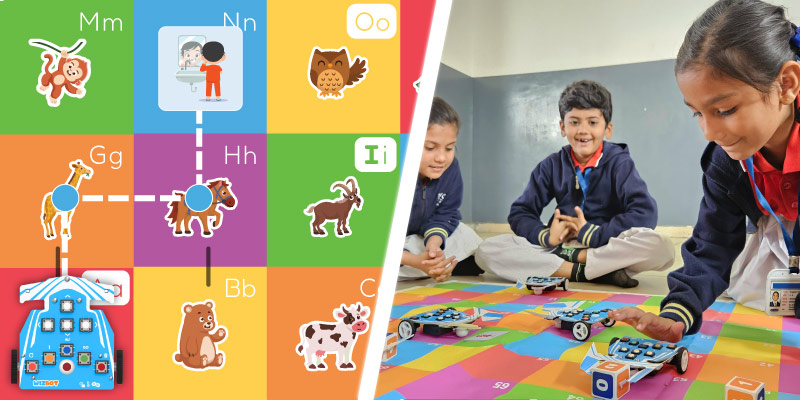In a rapidly evolving world driven by technology, it is imperative to equip students with the knowledge and skills necessary to thrive. Teaching Artificial Intelligence (AI) in schools has emerged as a vital component of preparing students for the future. Artificial Intelligence in classrooms helps students in learning 21st century skills and prepares them for the digital age.
In this blog, we will delve into the art of teaching Artificial Intelligence, unveiling effective strategies that empower educators to foster a deep understanding of this transformative field.
Importance of Teaching Artificial Intelligence in School
Integrating AI education into schools is of utmost importance. It equips students with the necessary skills and knowledge to thrive in the future. By introducing AI concepts, tools, and applications at an early stage, teachers prepare them for a world where AI will play a significant role in various industries and sectors.
AI education goes beyond technical proficiency. It nurtures critical thinking abilities by encouraging students to analyze data, solve complex problems, and make informed decisions. They learn to evaluate the ethical implications of AI technologies, ensuring responsible and ethical use in their future endeavors.
Let’s have a look at the benefits of teaching AI in schools.
Fostering Creativity in the Classroom with Artificial Intelligence
Teaching AI encourages students to become creators rather than passive consumers of technology. By engaging in AI projects, students gain hands-on experience and develop critical skills such as logical reasoning, algorithmic thinking, and problem-solving.
AI can be incorporated in the classroom in the following ways
- Students may be interested in exploring AI in social media filters like Instagram and Snapchat, smartphone cameras, robots, and navigation systems.
- Teachers can implement design thinking which cultivates compassion and innovative problem-solving.
- Students can analyze past incidents in social science or delve into the concepts of science.
Equipping Students through AI Education
Early exposure to AI education has numerous advantages for students as they progress through college and choose their career paths. With the increasing integration of AI in various industries, possessing AI knowledge provides students with a competitive edge in the job market. Integrating AI education empowers students by cultivating critical thinking, problem-solving, and creativity. As a significant portion of future jobs will rely on AI technologies, students equipped with AI skills are better positioned for employability and career success.
Integrating AI in the Classroom to unleash Imagination
In today’s world, children regularly encounter AI technology in their daily lives, from smartphones to software applications and cars. Their natural curiosity drives them to comprehend the underlying principles behind these technologies. By introducing AI education, teachers can answer their innate eagerness to understand how AI works, empowering them with knowledge about this transformative technology. Through exploration and learning, teachers can fuel their curiosity and pave the way for a future generation that embraces and shapes the potential of AI.
Benefits of AI Integration for Teachers
AI not only benefits students but also empowers educators in the teaching process. AI tools assist teachers in creating personalized learning experiences, identifying individual learning gaps, and providing targeted feedback. With the help of AI labs and tools, teachers can easily integrate AI concepts into various subjects, making learning more interactive, enjoyable, and effective.
Now let’s move ahead to see what resources will be required to teach AI in school.
Resources Required to Teach AI in Schools
Teaching artificial intelligence (AI) in schools is becoming increasingly important in today’s digital age. It equips students with valuable skills and knowledge that will be vital for their future. However, implementing AI education in schools requires careful planning and the allocation of appropriate resources.
AI-Enabled Classroom
AI-enabled classrooms have transformed traditional learning by replacing chalkboards with advanced technology.
An AI-enabled classroom refers to a physical environment equipped with technological resources that facilitate the teaching and learning of AI concepts. It may include devices like computers, tablets, interactive smart boards, and internet connectivity. For example, students can use computers to access online AI learning platforms or collaborate on AI projects using interactive smartboards.
Structured AI Curriculum
A structured curriculum is essential to teach AI effectively in schools. It should include a step-by-step progression of AI concepts, starting from the basics and gradually advancing to more complex topics. Different boards of education have suggested different frameworks of AI Curriculum such as ICSE Robotics and AI Curriculum (Subject Code 66), CBSE AI and Coding Curriculum ( Subject Code 417 and 843).
The curriculum should cover areas such as machine learning, neural networks, computer vision, and natural language processing. For instance, students can begin with learning about AI applications in daily life and later move on to understanding algorithms and coding in AI.
Hardware and Software Requirements to Teach AI in Schools
Teaching AI requires appropriate hardware and software resources. Hardware requirements may include computers, laptops, or other devices capable of running AI-related software. Hardware also refers to DIY Educational Robotic Kits which can engage the students in robot programming. AI Education Software for School may include programming languages like Block-based coding, Python Programming, it may also include Machine Learning, 3D AR and VR features and other data visualization tools.
Learning and Teaching Resources
A variety of learning and teaching resources are necessary to enhance students’ understanding of Artificial Intelligence. For Educators, these resources can include AI grade-wise lesson presentations to teach in the classrooms, Grade-wise AI lesson plans, etc. For students, these resources can include AI textbooks, AI practical activity books, tutorials, Assignment and Quizzes, interactive simulations, and AI-based educational games for students.
Teachers Training on AI and Coding
Teachers require thorough training to effectively teach AI concepts. They need a solid understanding of AI fundamentals, familiarity with relevant tools, and the ability to guide students in their AI learning journey. Training can include workshops, online courses, and professional development sessions.
For instance, workshops can help teachers integrate AI activities into lesson plans and offer guidance on AI projects for students. Coding, Python, and AI training are essential for educators to successfully incorporate these technologies into education.
Now let’s move ahead to talk about challenges in teaching AI in classrooms and how to overcome it.
Overcoming Challenges for Advancing AI Education
Challenges in advancing AI education include limited access to resources and infrastructure, a shortage of qualified AI educators, difficulty in curriculum development, ethical and social implications, and a lack of diversity and inclusion.
Here are few things that can be done to overcome the challenges faced while teaching Artificial Intelligence in school :
- Access: Provide online platforms, open resources, and affordable/free AI tools.
- Qualified educators: Invest in training programs and knowledge-sharing platforms.
- Curriculum development: Develop adaptable curricula with practical applications and ethical considerations.
- Ethical and social implications: Include modules on ethics, bias, privacy, and societal impact.
- Diversity and inclusion: Promote recruitment, mentorship, scholarships, and partnerships for underrepresented groups.
By implementing these solutions, we can work towards overcoming the challenges and create a more accessible, inclusive, and ethically aware AI education ecosystem.
Additional Tips to Teach AI in Schools
When teaching Artificial Intelligence in schools, here are some valuable tips to enhance the learning experience:
- Start with the basics: Introduce fundamental AI concepts and build upon them gradually.
- Use real-world examples: Connect AI to practical applications to demonstrate its relevance and capture students’ interest with real-world problem solving practices with Artificial Intelligence.
- Make it fun: Incorporate interactive activities, games, and projects to engage students in Artificial Learning.
- Be patient: AI can be complex not only for students but for teachers as well, so provide clear explanations, encourage questions, and foster a supportive learning environment.
STEMpedia’s AI Lab: A Perfect Solution to Teach AI in School
AI and Robotics Lab for schools is a holistic package with DIY Robotics kits, Coding Software, Teaching Resources, and Learning Management Systems to impart the best Coding, AI, and Robotics education with hands-on learning.
It is designed with grade wise certified curriculum and is aligned various education boards. We also provide onsite capacity training for computer teachers for efficient functioning with year-long hand-holding and end-to-end support.
In a Nutshell
Teaching AI in schools is crucial for preparing students for the future. It fosters creativity, critical thinking, problem-solving and other 21st century skills while equipping them with the knowledge needed to navigate a technology-driven world. By integrating AI tools and resources, teachers can provide personalized learning experiences and gain valuable insights into student progress. Overcoming challenges like limited resources and diversity issues can be addressed through online platforms, training programs, and inclusive practices. By embracing AI education, we empower students to become creators and innovators, shaping the future of AI responsibly and ethically.














